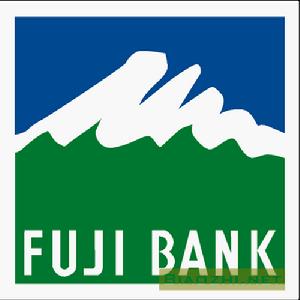日本富士銀行官方網站網址:http://www.fujibank.co.jp/
日本富士銀行簡介
2000年9月29日由富士銀行、第一勸業銀行和日本興業銀行組成日本瑞穗金融集團,於2003年1月成立。
日本富士銀行 (株式會社富士銀行,日文:Kabushiki-gaisha Fuji Ginkō,英文:The Fuji Bank, Limited,簡稱Fuji Bank)。
日本富士銀行是日本和世界大商業銀行之一,是日本芙蓉企業集團(富士集團俗稱)的骨幹企業之一,集團成員還包括眾多日本及世界馳名企業,如佳能、日立、日產汽車、山葉、丸紅等。
富士銀行的前身是1863年安田善次郎開設的安田屋兌換店。1866年,安田屋改名為安田商店,並逐步擴大了經營範圍。1880年安田商店改稱合平安田銀行,除繼續經營兌換業務外,又擴大了存款、放款業務。1900年,改名為安田銀行。1923年11月合併了安田系統的11家銀行後,成立了新安田銀行,是當時日本規模最大、實力最雄厚的銀行。1943年4月,安田銀行合併了日本晝夜銀行,1944年8月又合併了昭和銀行和第三銀行。1946年9月,安田財閥的最高領導機構——安田保善社被解散。作為安田財閥核心的安田銀行也被解散。1948年4月,駐日美軍當局提出銀行不適用集中排除法,安田銀行原封不動地得到恢復。同年10月,安田銀行在改名富士銀行後重新開業。
富士銀行從事的業務主要有存款、貸款,有價證券投資,國內匯兌,國外匯兌,公司債的受託和登記;兼營業務主要有代理、保管、有價證券的貸款、債務保證等。
到1987年3月底止,富士銀行在國內擁有249家分支機構,在國外設有14家分行和32個辦事處。以富士銀行為核心的芙蓉集團還有29家直系公司和54家旁系公司。
富士銀行非常重視中國業務,也是最早開展中國業務的日本銀行之一,1972年至今,富士銀行高層頻繁訪華,多次受到國家領導人的接見。銀行現已同中國最主要的24家銀行和信託公司簽訂了業務合作協定。1982 年至今,在中國舉辦了大量金融課題研討會,並邀請大量中國各方人員赴日研修培訓。富士銀行現在中國大陸設7個分支機構,遍布中國東北、華北、華東和華南地區,並在中國設立了2家日中合資企業。
銀行歷史
富士銀行在東京的總部,現在的瑞穗集團總部Foundation and Development(成立與發展)
Fuji Bank traces its history as far back as the old Yasuda zaibatsu.
In 1864, twenty-one year old Zenjiro Yasuda migrated from Toyama to Edo, settling in Nihonbashi, where he opened a dry goods store, simply titled Yasuda-ya (lit. Yasuda & Company). After the Meiji Restoration in 1869, the company positively underwrote bonds for Japanese government, whose credit standing was low then, and restore large treasury surplus. The company also financed many public works such as railroads, harbor constructions, and so forth.
The company became incorporated in 1880, with a solid capital of 10 million yen accumulated in Yasuda-ya period, and changed its name to Yasuda Bank. In Taishō period, the Japanese banking community were thrown into financial difficulties because of World War I and 1923 Great Kanto earthquake. Yasuda Bank aided many minor, small or medium banks, 11 of which were merged into Yasuda Bank in 1923. This merger helped Yasuda Bank become the largest Japanese bank in terms of deposits.
After World War II(二戰後情況)
Following World War II, Yasuda zaibatsu were dissolved by the SCAP. On October 1, 1948, Yasuda Bank changed its name to The Fuji Bank, Limited. “Fuji” was named after Mount Fuji, which is a world-famous symbol of Japan, Fuji Bank aiming to be a world-famous Japanese bank. Fuji Bank formed Fuyo Group, one of the largest keiretsus, together with former Yasuda zaibatsu companies.
As the Japanese economy developed, Fuji Bank expanded its business, with leadership positions in syndicated lending, corporate banking, public money management, mortgages, and retail financial services.
Fuji Bank Ebisu Branch's sign on the cover of Mogwai's Young TeamDecline and Merger(衰落與合併)
In 1970s, Sumitomo Bank began to gain market share at Fuji Bank's expense in the retail banking. Fuji impatiently entered into rivalry with Sumitomo. In the later 1980s, however, the Japanese asset price bubble comes, and the Japanese banks granted increasingly risky loans. After the bubble's collapse, Fuji's progressive plan also backfired. Fuji lost a great deal of money, swamped by non-performing loan.
In order to find a way out of the difficulties, Fuji Bank attempted to diversify its services, establishing Fuji Securities and Fuji Trust & Banking Co. in 1994. These subsidiaries, however, didn't make so large a profit. Meanwhile, Fuji Bank had to restructure, lay off thousands of employees and sold its 52% stake in Heller Financial to GE Capital.
A very successful derivatives sub company, Fuji Capital Markets Corp was founded in New York in 1990 going on to become one of the lead players in the swaps market. FCMC went on to open an offices in London in 1992 and Hong Kong in 1994 which still exist as Mizuho Capital Markets Corp. FCMC was noted at the time for its relatively advanced technology, and was one of the first Japanese Banks to connect to the internet, registering the fcmc.com domain in 1993.
On November 24, 1997, Yamaichi, Fuji Bank's affiliated securities firm, announced it would cease operations and was declared bankrupt by the Tokyo District Court. In addition, Yasuda Trust & Banking, Fuji Bank's affiliated Trust Company, ran into problems with earnings and credit quality in 1999. Fuji Bank bought a controlling stake in Yasuda Trust, but Fuji couldn't reconstruct Yasuda for itself any longer .
Just in time, Dai-Ichi Kangyo Bank proposed to Fuji its becoming a “white knight” for Fuji. Dai-Ichi Kangyo held superior assets, but was left behind the current of the Japanese banks mergers. Fuji Bank weakened by its non-performing loan had no choice but to merge with Dai-Ichi Kangyo, along with the Industrial Bank of Japan, creating Mizuho Financial Group in 2000.
During the September 11, 2001 attacks on New York, Fuji Bank's United States offices were located at the impact zone of United Airlines Flight 175 in Tower 2. Fifteen Fuji Bank employees died in the attack.

